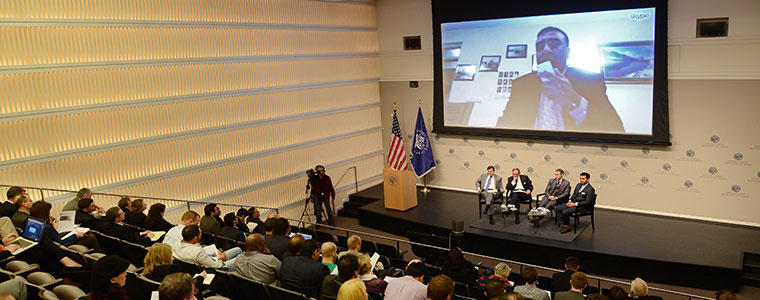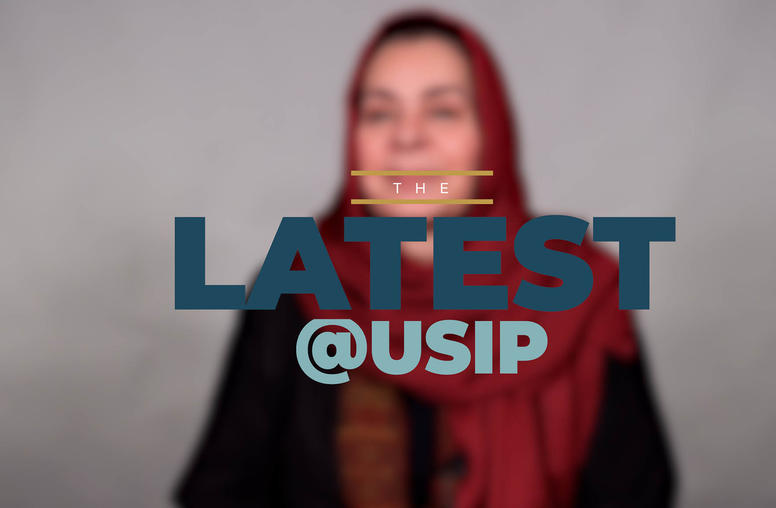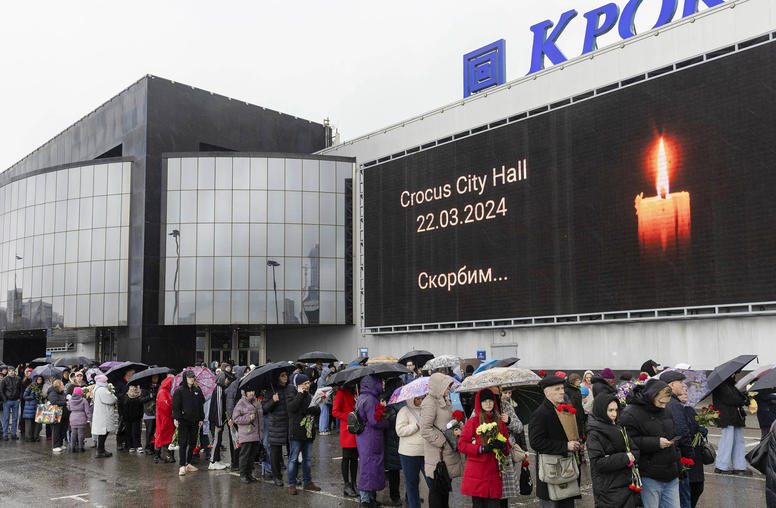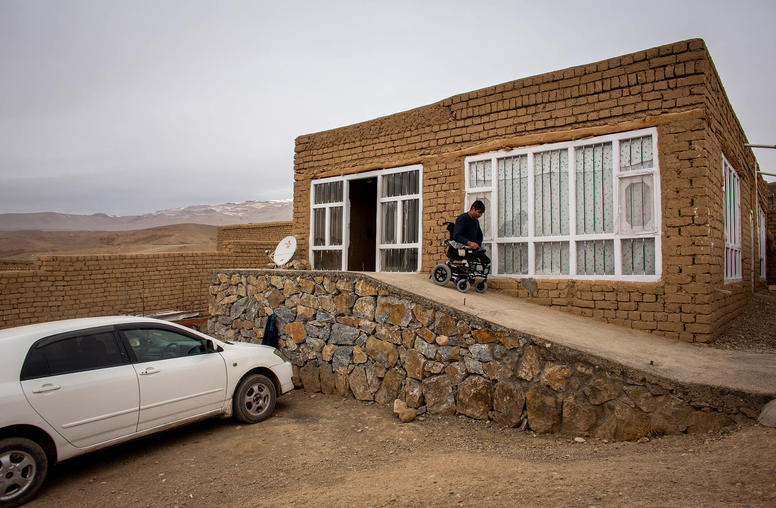Next Steps for Afghanistan
“The Afghan people voted for change. Change in life, in educational and employment opportunities, in better governance,” Shahmahmood Miakhel, USIP’s Afghanistan country director and former Afghan Deputy Minister of Interior, said at a USIP event First Impressions of the Afghan Elections on April 9.

Just days after Afghanistan’s April 5 elections, USIP gathered experts in Washington and by Skype from Kabul to analyze their significance for Afghanistan, the United States and the world.
The experts in Kabul were USIP’s Shahmahmood Miakhel, Najla Ayubi of The Asia Foundation, Nader Nadery of the Free & Fair Election Forum of Afghanistan (FEFA), and Nargis Nehan of Equality for Peace and Democracy. Speaking to the audience at USIP’s headquarters in Washington D.C. were Peter Manikas with the National Democratic Institute, Jed Ober with Democracy International and Hamid Arsalan with the National Endowment for Democracy. USIP’s director for Afghanistan and Central Asia programs, Scott Smith, moderated the discussion.
The Kabul participants stressed that the presidential and provincial council elections exceeded even optimistic expectations. Voter turnout was high—nearly double that of the 2009 elections. Election Day violence was contained, and initial reports suggest that the electoral and security institutions performed well.
Nearly 78 percent of the population participated in some capacity in last week’s election, Nadery estimated. This participation took many forms: an estimated 7 million Afghans voted out of a population of approximately 30 million, 36 percent of voters were women. Some citizens participated as elections observers. Others led civic awareness campaigns and attended candidate rallies. Afghanistan’s increasingly sophisticated media played an important role in covering the campaign and providing information to prepare voters for Election Day. And Afghan security forces implemented a well-organized operation to maintain security around the country—despite Taliban threats and a wave of attacks in Kabul in the weeks before the election.
This was the first Afghan election that was held within the Constitutional timeline. Despite bad weather on Election Day, millions of Afghans who wanted to exercise their right to vote were not deterred. Voters this year were more aware of voting procedures and candidate positions due to widespread voter education campaigns, well-attended rallies and massive media coverage. The Independent Election Commission (IEC) and the Independent Elections Complaint Commission (IECC) met every deadline set in terms of ballot printing, ballot delivery, elections observer training and passage of election-related legislation.
While welcoming these early indicators of a successful event, panelists cautioned that the process had merely begun, and complications were likely to arise as the vote tabulation process began, results began to be released, and more detailed reports of fraud and security problems were released. The possibility of a second round, if no candidate reaches 50 percent in the April 5 election, would create additional complications.
What Comes Next?
While it is unlikely that fraud was as widespread as it was in 2009, it undoubtedly still occurred. As of April 9, there were already reports of both fraud and irregularities, in particular an absence of ballots. Nadery noted that FEFA’s observers detected a correlation between polling stations where observers were barred (against the regulations) and where ballots were said to be depleted in the first hours of polling. This suggested planned illegal ballot stuffing. It is the responsibility of the IECC to address these issues.
After observers, candidates and candidate agents have filed their complaints, the complaints adjudication process begins. The IECC will then make recommendations to the IEC on how to address those complaints that are deemed to have the potential of affecting the outcome of the election. It is crucial that this process is conducted in such a way that all candidates feel that it was a fair and open process so that the results are not disputed by leading candidates as they were in 2009, according to Najla Ayubi, deputy country representative with The Asia Foundation based in Kabul.
According to the IEC’s provisional calendar, the vote count and complaints adjudication should be finalized by May 26. At that point, the need for a run-off will be clear.
According to Ober, fraud could complicate the question of the run-off in two ways. First, if a candidate is close to 50 percent of the vote, and alleges that without fraud he would have attained the 50 percent threshold. Second, if the two second place candidates are close, each could use evidence of fraud to argue that they should contest the second round.
Manikas raised an additional possible complication. According the Afghan constitution, President Hamid Karzai’s term ends on May 22, 2014, six days before the scheduled run-off, but several months before the next president is likely to assume office. Manikas raised the possibility of calls for an interim government. USIP’s Scott Smith acknowledged that such calls were possible, but noted that this situation had already occurred in 2009, when the election took place long after the constitutional date of the end of President Karzai’s first term. In that case, Smith said, “there is already a Supreme Court precedent stating that the incumbent president remains in office until the new president is sworn in.” No decision made by the current government on what should happen during this period.
The Next Government
A year ago, many might have thought that President Hamid Karzai was not going to relinquish his role as president, Nehan observed. The current Afghan government has, however, made all necessary preparations thus far to transition power to the next government. Both the current government and the candidates now need to start preparing what the future Afghan government will look like.
The leading candidates have all said that they are likely to include representatives from the competing campaigns in their government. The next cabinet is also likely to include a higher representation of women; based on the high turnout of women voters, noted above, the future government will have to answer to the concerns of the female electorate much more than they previously have, according to Ayubi.
Each of the top candidates has also committed to signing the Bilateral Security Agreement (BSA) with the United States, which President Karzai has so far refused to sign, despite its ratification by a specially-convened national assembly. The BSA will allow U.S. and NATO troops to remain in Afghanistan to train and support Afghan security forces, as well as continue to provide funding to the Afghan security forces.
“Afghanistan’s security forces alone require $5 billion per year. Afghanistan’s economy is not strong enough to support even just that. No one wants to be known as the president that bankrupt Afghanistan,” Arsalan said.
In addition to signing the BSA, the next president is likely to want to improve its foreign relations. Each of the candidates is also likely to want to improve cooperation within the region, particularly with Pakistan.
The panel also noted that the next government will also have to face a number of domestic issues such as corruption, high unemployment and the drug economy.
While Afghanistan’s problems remain complicated, the positive picture of the April 5 election may make them easier to solve. If the complications of counting and complaint adjudication are surmounted, and a possible second round carried out successfully, the government that emerges would benefit both from renewed domestic legitimacy and international support. Not long ago, few would have predicted even the possibility of such optimism, but this election might be the turning point that Afghanistan needs.



